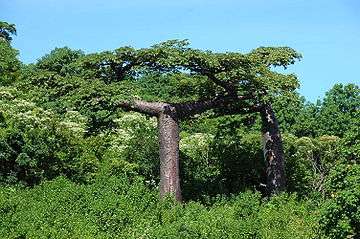Adansonia suarezensis
| Adansonia suarezensis | |
|---|---|
 | |
| Scientific classification | |
| Kingdom: | Plantae |
| (unranked): | Angiosperms |
| (unranked): | Eudicots |
| (unranked): | Rosids |
| Order: | Malvales |
| Family: | Malvaceae |
| Genus: | Adansonia |
| Species: | A. suarezensis |
| Binomial name | |
| Adansonia suarezensis H.Perrier | |
Adansonia suarezensis, the Suarez baobab, is an endangered species of Adansonia endemic to Madagascar.
Description
A. suarezensis is a large tree with a tall, cylindrical trunk. The bark is smooth and greyish-brown and a photosynthetic greenish layer can be seen underneath. The short, thick branches project horizontally from high on the trunk forming a horizontal crown. The leaves are palmate, yellowish-green and deciduous. Large white flowers are produced after the leaves have fallen, followed by dangling, elongated fruit that can weigh as much as 1 kilogram (2.2 lb).[2]
Distribution and habitat
A. suarezensis grows in the northern tip of the island of Madagascar near Antsiranana Bay. A further population has been found growing between the Ankarana Reserve and the Analamerana Reserve in the Forest of Mahory. Its typical habitat is deciduous woodland in limestone areas but it also grows in disturbed scrub.[1]
Ecology
The flowers are strong smelling and produce copious nectar and are visited by bees, moths and sunbirds but none of these are big enough to pollinate it.[2] At times of year when fruit is not available, the Madagascan fruit bat feeds on nectar and has been observed to visit the flowers of A. suarezensis and the kapok tree Ceiba pentandra. This bat is believed to be a significant pollinator of the flowers of these trees.[3]
Status
The IUCN lists A. suarezensis as being "Endangered" in its Red List of Threatened Species. This is because little natural regeneration has been observed except in the Mahory Forest, and mining in the area in which it grows means that there is a demand for timber and charcoal, and pressure from agriculture and grazing.[1] No Madagascan animals have been identified as dispersing the seed of this tree.[2]
References
- 1 2 3 World Conservation Monitoring Centre (1998). "Adansonia suarezensis". IUCN Red List of Threatened Species. Version 2013.1. International Union for Conservation of Nature. Retrieved 2013-12-07.
- 1 2 3 "Suarez baobab (Adansonia suarezensis)". ARKive. Retrieved 2013-12-07.
- ↑ Andriafidison, Daudet; Andrianaivoarivelo, Radosoa A.; Ramilijaona, Olga R.; Razanahoera, Marlène R.; MacKinnon, James; Jenkins, Richard K. B.; Racey, Paul A. (2006). "Nectarivory by Endemic Malagasy Fruit Bats During the Dry Season". Biotropica. 38 (1): 85–90. doi:10.1111/j.1744-7429.2006.00112.x.
